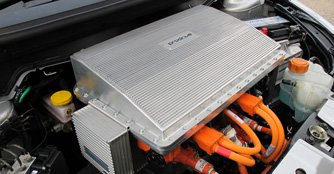Prodrive successfully tests silicon carbide DC-DC converter
11 Jul 2014|1,594 views

It has four ports - two connect to the traction motor and high-voltage battery; a third connects to a secondary energy source, which in this test car is a super capacitor bank; and the fourth powers the vehicle's 12V systems.
The converter is able to match the voltages of these components and transfer energy between them in response to CAN commands from an external supervisory controller.
A key aspect of the converter is the use of silicon carbide devices. These operate at a much higher frequency than equivalent silicon components - at 75kHz in the test vehicles - with a significant reduction in switching losses.
This has resulted in a significant reduction in the size of the magnetic components and has enabled the converter to achieve a class leading efficiency of 98.7 percent, a gravimetric power density of 10.5kW/kg and a volumetric power density of 20kW/litre.
The consortium is now working on a follow up project which increases the converter operating voltage to 750V, power density and demonstrates operation at increased coolant temperatures.
A consortium led by Prodrive has successfully run a silicon carbide-based multiport DC-DC converter in an electric car. The DC-DC converter acts as a hub that transfers energy between key components of the vehicle's high-voltage electrical system.
It has four ports - two connect to the traction motor and high-voltage battery; a third connects to a secondary energy source, which in this test car is a super capacitor bank; and the fourth powers the vehicle's 12V systems.
The converter is able to match the voltages of these components and transfer energy between them in response to CAN commands from an external supervisory controller.
A key aspect of the converter is the use of silicon carbide devices. These operate at a much higher frequency than equivalent silicon components - at 75kHz in the test vehicles - with a significant reduction in switching losses.
This has resulted in a significant reduction in the size of the magnetic components and has enabled the converter to achieve a class leading efficiency of 98.7 percent, a gravimetric power density of 10.5kW/kg and a volumetric power density of 20kW/litre.
The consortium is now working on a follow up project which increases the converter operating voltage to 750V, power density and demonstrates operation at increased coolant temperatures.
It has four ports - two connect to the traction motor and high-voltage battery; a third connects to a secondary energy source, which in this test car is a super capacitor bank; and the fourth powers the vehicle's 12V systems.
The converter is able to match the voltages of these components and transfer energy between them in response to CAN commands from an external supervisory controller.
A key aspect of the converter is the use of silicon carbide devices. These operate at a much higher frequency than equivalent silicon components - at 75kHz in the test vehicles - with a significant reduction in switching losses.
This has resulted in a significant reduction in the size of the magnetic components and has enabled the converter to achieve a class leading efficiency of 98.7 percent, a gravimetric power density of 10.5kW/kg and a volumetric power density of 20kW/litre.
The consortium is now working on a follow up project which increases the converter operating voltage to 750V, power density and demonstrates operation at increased coolant temperatures.
Latest COE Prices
August 2025 | 1st BIDDING
NEXT TENDER: 20 Aug 2025
CAT A$102,009
CAT B$123,498
CAT C$70,001
CAT E$122,334
View Full Results Thank You For Your Subscription.

















